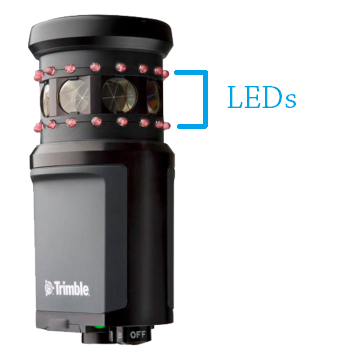- And how to mitigate elevation errors using Access software in semi-active mode.
Several weeks into an asphalt paving job, one of our clients started to experience elevation discrepancies – as much as a tenth of a foot in some cases. Through some thorough field tests by the survey crew, comparing multiple robotic total stations, they determined the errors were caused by two of their Trimble MT1000 MultiTrack prisms.
The contractor was running a Trimble PCS900 3D machine control system on an asphalt paving machine. For real-time quality control, grade-checkers were constantly verifying elevations behind the paver - using the same SPS930 instruments with MT1000 ActiveTrack prisms. That's a lot of moving pieces, so needless to say, there was a lot of head scratching and hot asphalt getting cold.
What causes elevation errors with the MT1000:
Positioning Solutions specializes in providing our clients with the highest quality used Trimble products, so when we were informed of the issue we made it a priority to test all of the pre-owned MT1000 prisms that were in our inventory. To get started, it's important to understand how the MT1000 works.
 The MT1000 has a ring of 32 LEDs (light emitting diodes) which circle the outside of the prism 360 degrees. These LEDs emit a signal and a user selected Target ID which Trimble instruments track when the Tracking mode is set to Active.
The MT1000 has a ring of 32 LEDs (light emitting diodes) which circle the outside of the prism 360 degrees. These LEDs emit a signal and a user selected Target ID which Trimble instruments track when the Tracking mode is set to Active.
The LEDs are exposed through the aluminum housing and because of this, they can easily be bent or broken when the prism is dropped, mishandled or stored improperly.
Its important to note that an LED that is out of alignment is not always obvious, you may not see any signs of abuse, so it’s important to check your prisms for accuracy regularly.
Upon initial inspection of the MT1000 pictured below, it was not obvious that it had been dropped. In fact, it was in like-new condition. However, when taking a closer look and checking each LED individually, we found two of the LEDs had been pushed in - and that's all it takes to cause a vertical error.


Keep in mind, this will only cause vertical errors when the damaged side of the prism is facing the instrument. This prism can still be used accurately - just make sure the damaged side is marked so you know to keep this side facing away from the instrument when taking precise shots like control points or any point where accuracy of elevation is critical. Alternatively, keep this prism for less accurate work like automated topo shots.
How to check your MT1000 prism for vertical errors:
Find a good space for testing – a flat field with little change in elevation and at least 300 feet between the instrument and prism. We used a 1” Trimble S6 robotic instrument that had recently been calibrated, set up approximately 350 feet from the prism to conduct measurements.
Reminder: With tracking mode set to Passive, the instrument tracks the glass. When tracking mode is set to Active, the instrument tracks the LEDs. This is independent from the Autolock feature.
Checking the glass in passive mode:

1. Place the MT1000 on a tripod with level tribrach and rotating base. Mark each side of the prism to keep track of your measurements. We recommend marking each quadrant with letters; A,B,C,D to avoid confusion between the instrument face 1 and face 2 positions.
2. Using Trimble Access (2017 or newer) under Target controls, set the tracking mode to Passive and enable Autolock. Use the Search function or aim at the MT1000, allowing the Autolock function to “lock” on to the target, Take measurements in both face 1 and face 2 of the instrument. You should see little to no deviation.
3. Rotate the MT1000 to the the next quadrant (A to B) and using the Stakeout Point function, stakeout the point measured in step 2. There should be little to no deviation. Continue to measure all 4 quadrants of the prism.
4. Rotate the prism so the side marked "A" is facing the instrument.
5. Change the tracking mode to Active and stakeout the point measured in step 2. Slowly rotate the MT1000 and closely monitor elevation values for any deviation. If you observe any significant value changes in either axis, your MT1000 is likely the culprit.
We tested 5 (used) MT1000 prisms and found vertical errors in one. From quadrants A, B and D, we measured tiny but acceptable vertical deviation. However - from A to C we observed a .05 change in elevation values. Again switching between Active and Passive tracking allows you to change focus from the glass to the LEDs.
The bad news about MT1000 prisms:
The MT1000 cannot be repaired, and at nearly $3,000 for a new one - don't just throw it in the closet. They can still be used, even when precision is required.
Best of both worlds - Trimble Access semi-active tracking mode:
![]()
If your running Trimble Access 2017 or newer, you have the option to select between Passive, Active and Semi-active tracking modes. When the Tracking mode is set to Semi-active, the LEDs are used to track the prism, and then automatically switches to passive tracking mode when taking a standard measurement. This results in more precise vertical angle measurements.
According to Trimble, the MultiTrack target should be used within the following vertical angle tolerances:
Active: + / - 15° from horizontal
Passive: + / - 30° from horizontal
Keep in mind, when passive tracking is used, you must be aware of nearby reflective surfaces which could interfere with the measurement.
Final Thoughts:
The MT1000 has been the premier choice available from Trimble since 2006 - and with good reason; it’s an excellent product, offers both passive and active modes and It’s glass plus LED design offers a visual target for surveyors who prefer to see what they measure. As with all precision survey equipment, as long as the equipment is well cared for – it will maintain its accuracy for a lifetime. Understanding how these systems operate - along with good survey practices - will ensure your measurements are always right.
